Learning and Development (L&D) strategy: How to create an effective one
Strong learning and development strategies are crucial amidst talent shortages to achieve business objectives.

The growing talent shortage has become one of the biggest challenges organizations are currently facing. In an effort to stay competitive, many companies are reimagining the employee experience with offerings like four-day workweeks, increased flexibility, and appealing learning and development opportunities.
In this context, there has never been a more important time to have a clear and strong learning and development strategy in place. A good strategy defines the actions a business should take and the priorities, acting as a guiding principle to achieving the expected goals.
“A good strategy provides a clear roadmap, consisting of a set of guiding principles or rules, that defines the actions in the business should take (and not take) and the things they should prioritize (and not prioritize) to achieve desired goals.”
– Watkins (2007), Demystifying Strategy: The What, Who, How, and Why, Harvard Business Review.
Discover:
- What is a learning and development strategy?
- What is the purpose of an L&D strategy?
- Benefits of a successful L&D strategy
- The stakeholders involved in the L&D strategy
- What influences an L&D strategy
- Six steps to build an L&D strategy
- Five examples of L&D strategies that can inspire you
- The importance of online platforms to learning and development
What is a Learning and Development (L&D) strategy?
As an organizational plan, it should be cost-effective, time relevant, add value for the stakeholders, and align with the business strategy.

L&D strategy framework
You will receive a list of questions along with a spreadsheet template to help you analyse your L&D strategy.
DOWNLOAD FRAMEWORKThe purpose of an L&D strategy
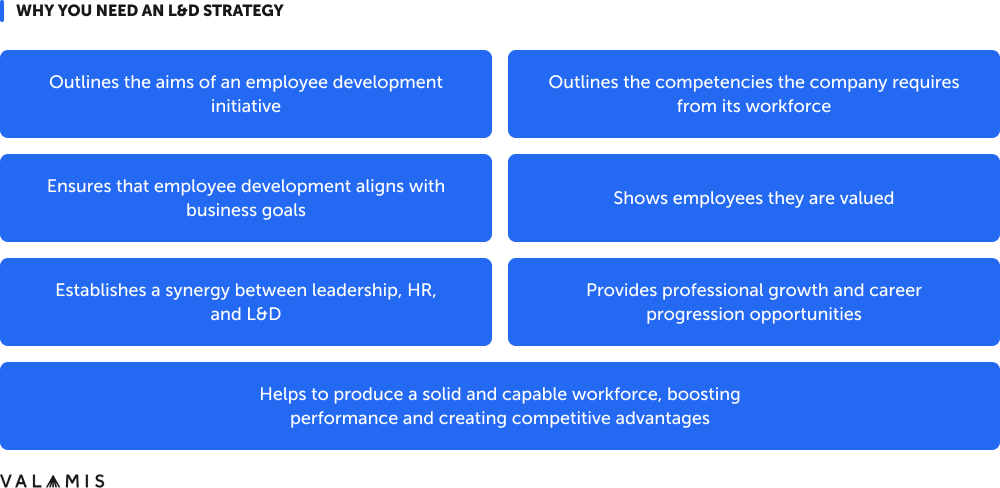
L&D strategy outlines the aims of an employee development initiative, ensuring they align with broader business goals.
Defining a corporate L&D strategy establishes a synergy between leadership and HR to help design training courses and personal development programs for employees throughout the organization.
L&D strategy is a critical part of an organization’s wider business strategy. It outlines the competencies the company requires from its workforce so that L&D staff can focus their efforts on a specific strategy.
Successful L&D strategies produce effective employees with the knowledge, skills, and capabilities required to improve the organization’s performance.
While L&D strategies are critical for businesses operating in evolving markets, they also produce significant employee benefits:
- Investing in L&D shows staff they are valued and provides professional growth and career progression opportunities.
- Aligning L&D strategy with business strategy helps to produce a strong and capable workforce, boosting performance and creating competitive advantages.
Even though there are significant benefits, research shows only 40% of companies say their learning strategy is aligned with business goals. Given that more than half of businesses fail to connect their learning initiatives to their objectives, companies that take the time to develop an explicit L&D strategy can see significant benefits.
When an organization aligns its L&D strategy with corporate goals, it can:
- Identify existing skills gaps hindering their operations and develop adequate upskilling or reskilling programs
- Secure a talent pipeline, including leadership development plans to help appropriately manage succession planning
- Enhance the workplace culture and promote continuous learning
- Workforce planning to adapt to new technologies and deliver successful digital transformation projects
- Make partner onboarding smoother by offering clear, easy-to-follow training that helps them understand your brand and work better with you.
- Simplify customer onboarding by creating tailored learning experiences that guide them through your solutions, building stronger connections and happier clients.
Benefits of a successful L&D strategy
While there is overlap, the benefits produced by implementing a successful corporate L&D strategy can be separated into those for the employee and the employer.

Employee benefits
- Engagement – Developing employees and investing in their capabilities promotes workplace satisfaction and engagement. Most staff members like learning new skills and feeling valued by their employers.
- Collaboration – Group learning and knowledge-sharing can produce greater cohesion and togetherness within a team. This helps promote communication between employees and find new opportunities for collaboration.
- Job security – Employees who develop their skills and get better at their job become more valuable to employers, increasing their job security.
- Employability – This can also help increase their employability to other organizations should they move on.
- Internal mobility – Similarly, training can help employees transition to new, often more financially lucrative, roles within the organization. L&D strategy can identify previously untapped skills contributing to greater career development and potentially leading to promotions.
Employer benefits
- Productivity – When successful, employees’ improved performance and productivity post-L&D outweigh any time set aside for training courses and self-study. L&D strategy allows staff to get more work done in less time while also increasing the quality of their work and reducing the time required to fix any errors.
- Retention – Improved engagement and the potential for new challenges through internal mobility mean employees are more likely to remain at an organization with a strong L&D strategy and practices. Investing in employee careers helps incentivize employee retention.
- Recruitment – On a similar note, organizations can market themselves to potential hires by utilizing strong L&D strategies. With clear pathways to progress at the company, you can attract the best talent available.
- Competitive advantage – Knowledgeable employees can more effectively track new trends and developments within the industry, learning techniques to improve operations.
- Resilience – The L&D strategy helps develop the hard and soft skills employees need to adapt quickly to changes and pivot when unexpected situations occur. This could include knowledge of other business methods and products or the stress management and communication skills to reorganize work processes abruptly. With L&D practices in place, organizations become resilient in the face of volatile markets.

L&D strategy framework
You will receive a list of questions along with a spreadsheet template to help you analyse your L&D strategy.
DOWNLOAD FRAMEWORKThe stakeholders involved in L&D strategy
While the L&D team is likely responsible for designing, implementing, and assessing a new strategy, other key stakeholders are involved.
The specific stakeholders will depend on the chosen goals and the scale of the operation, but generally, they can be separated into three categories:
- Learners/employees
- Managers/supervisors
- Leadership
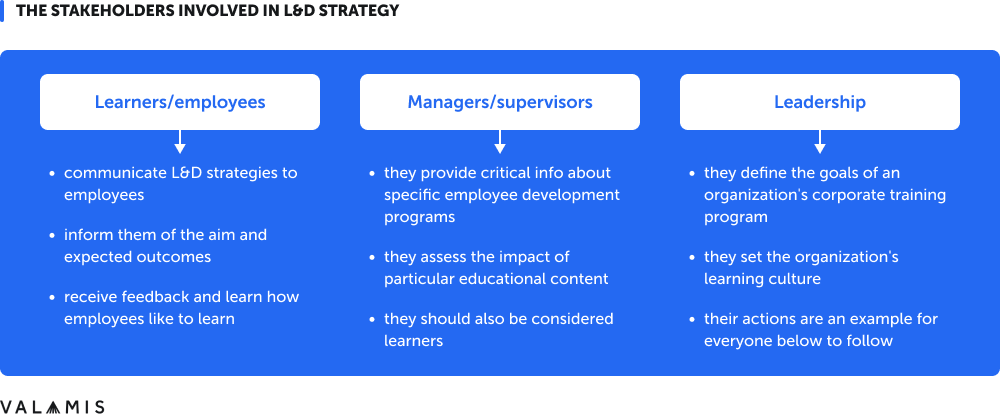
Learners
The employees are the ones learning new knowledge, skills, and capabilities to apply in their work.
Organizations should clearly communicate L&D strategies to employees, informing them of the aim and expected outcomes.
It is also helpful to receive feedback and learn how employees like to learn. Ultimately, the learners will experience the development programs and undergo the planned transformation, and their input is valuable.
Organizations must convey the importance of new L&D strategies and the potential benefits for employees. They also need to demonstrate they are willing to invest time and resources to help them acquire the new capabilities.
While many L&D activities will be mandated and scheduled (such as courses, workshops, etc.), others will need to be performed independently, and their success depends on the learners’ enthusiasm.
Managers
Line managers are crucial stakeholders who, depending on their attitude, can hinder or enhance an L&D strategy.
Buy-in from managers and supervisors is critical to the success of an L&D strategy. They are the people closest to the employees and will be able to provide critical information about specific employee development programs as well as assess the impact of particular educational content.
It is also important to remember that managers should also be considered learners. An effective L&D strategy includes learning objectives and new skills for managers to develop.
Leadership
While other stakeholders offer ideas and operational factors influence L&D strategy, it is leadership that will define the goals of an organization’s corporate training program.
Additionally, they set the organization’s learning culture, and their actions are an example for everyone below.
What influences an L&D strategy?
Generally speaking, two main factors influence L&D strategy, which in turn are the starting point for the strategy.
They are: 1) your business goals or strategic direction and 2) existing operational factors.
In short, this is the idealized version of what you want to implement and, realistically, what is possible.
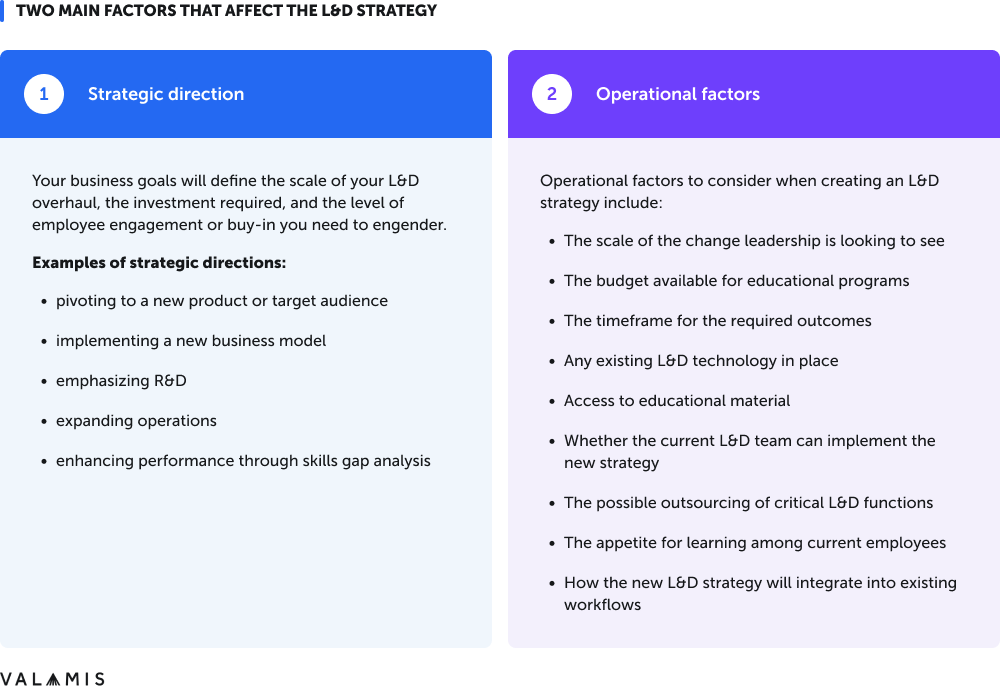
1. Strategic direction
The company’s strategic direction and goals should form the foundation of your L&D strategy.
This includes both internal context (e.g., previous business performance) and external context (e.g., market conditions).
Examples could include:
- pivoting to a new product or target audience
- implementing a new business model
- emphasizing R&D
- expanding operations
- and enhancing performance through skills gap analysis.
Some of these may include the entire organization, while others require focusing on particular departments.
Your business’s strategic direction should be the starting point for designing employee development programs and reskilling initiatives.
Your business goals will define the scale of your L&D overhaul, the investment required, and the level of employee engagement or buy-in you need to engender.
2. Operational factors
The final L&D strategy filters business goals through existing operational factors.
This includes the workplace culture and learning ecosystem already in place to determine if they are conducive to the new L&D plans or whether a fundamental change in L&D focus is needed.
Operational factors to consider when creating an L&D strategy include:
- The scale of the change leadership is looking to see
- The budget available for educational programs
- The timeframe for the required outcomes
- Any existing L&D technology in place
- Access to educational material
- Whether the current L&D team can implement the new strategy
- The possible outsourcing of critical L&D functions
- The appetite for learning among current employees
- How the new L&D strategy will integrate into existing workflows
How to build an L&D strategy
Every organization requires different outcomes from its L&D efforts.
Therefore, you cannot simply copy others or implement generic training programs with the hope of creating meaningful benefits
Instead, organizations wanting to maximize the impact of employee training must design their L&D strategy that fits their needs.
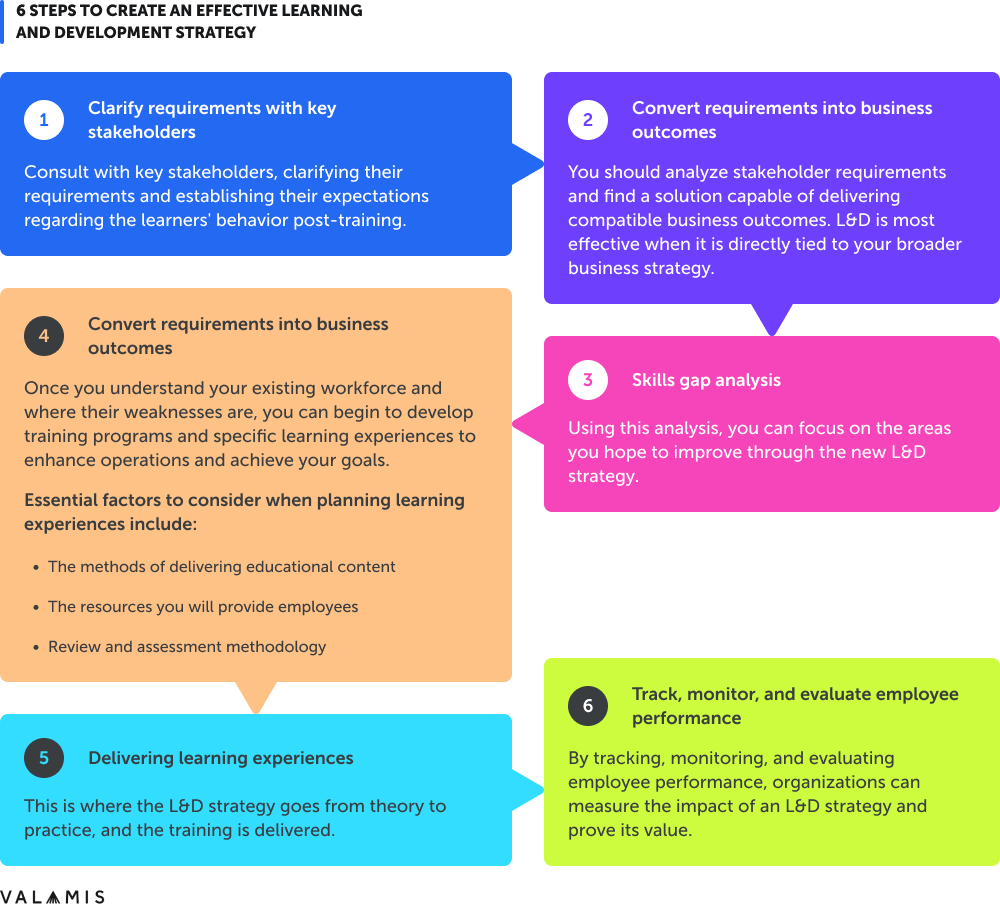
However, you can take several steps to help create an effective and successful L&D strategy
1. Clarify requirements with key stakeholders
The first step is to consult with key stakeholders, clarifying their requirements and establishing their expectations regarding the learners’ behavior post-training.
That means discussing L&D goals with employees, managers, and leadership and learning the most impactful outcomes for each of the main parties.
For example:
- Employees may want to focus on new skills to help them progress at the company or increase their job security.
- Managers may focus on training that improves team cooperation, making it easier for them to oversee a group of employees.
- Leadership may look at longer-term goals that protect the company’s market position and help deliver growth.
2. Convert requirements into business outcomes
Next, you should analyze stakeholder requirements and find a solution capable of delivering compatible business outcomes.
L&D is most effective when it is directly tied to your broader business strategy.
Therefore, you should set these requirements against what you hope to achieve and identify attainable goals you can accomplish via a new L&D strategy.
Setting goals from the outset informs every subsequent decision you make. Will this get the organization closer to our goals?
With clearly defined objectives in place, you have an outline to fall back on when making potentially tricky decisions.
These goals should also be communicated to all stakeholders for approval before implementing new L&D processes.
3. Skills gap analysis
Skills gap analysis is the process of assessing employees to determine the gaps between their existing capabilities and what you want from them in the future.
Using this technique, you can focus on the areas you hope to improve through the new L&D strategy. This could be performed company-wide or by focusing on the areas most closely related to the outcomes defined in step two.

How to conduct a skills gap analysis and what to do next
Start building your foundation for strategic workforce development.
Download guide4. Planning learning experiences
Once you understand your existing workforce and where their weaknesses are, you can begin to develop training programs and specific learning experiences to enhance operations and achieve your goals.
Successful L&D programs tailor content to be as impactful as possible for each employee while also allowing them to learn in the manner that suits them best.
Essential factors to consider when planning learning experiences include:
- The methods of delivering educational content – Many approaches are available to educate your staff, including formal scheduled training sessions and self-motivated study where employees are responsible for their own learning.
- The resources you will provide employees – Whether they are generated in-house, outsourced, or purchased, new L&D strategies will require new resources.
- Review and assessment methodology – How you, as an organization, will assess the performance of employees post-training. This could include testing to understand the learner’s new knowledge, training evaluation feedback to assess the course itself, or learning metrics to track behavioral changes and see how training is applied in the workplace.
Learn more about 5 Ways to Improve Employee Engagement with L&D
5. Delivering learning experiences
This is where the L&D strategy goes from theory to practice and the training is delivered.
A lot has to go right, including developing the right content for your employees and having instructors capable of engaging and informative sessions.
When building a new learning culture, it is crucial to establish how training and continuous education will become part of the workplace routine.
Learn How to Build a Learning Culture to enhance the overall learning experiences.
6. Track, monitor, and evaluate employee performance
The first two steps establish what stakeholders hope to achieve with a new L&D strategy. The final stage of the process is to track employee performance against these outcomes and assess the effectiveness of the training program.
By tracking, monitoring, and evaluating employee performance, organizations can measure the impact of an L&D strategy and prove its value. Part of this is understanding employee performance before implementing a new L&D strategy.
Without a baseline in place, organizations struggle to establish meaningful learning metrics that reflect the real impact of a training program.
Tracking performance and evaluating training effectiveness is a difficult task. You can ask for feedback and incorporate employee assessments to determine what was learned.
But it is more challenging to measure behavioral changes and determine whether the new capabilities were efficiently applied in the workplace.
Discover 10 Valuable Training Metrics to Know
5 Examples of effective L&D strategies that can inspire you
There are many examples of effective L&D strategies for different types of organizations and various industries. Examples include:
- Yelp – the online review site promotes learning and development through two core practices: stretch roles, allowing employees to find their passion, and promoting from within. A staggering 98% of Yelp’s sales management roles were internal candidates.
- Money Supermarket – the UK price comparison website transformed its L&D strategy during the pandemic launching a new online platform that tailors specific experiences to each role. This includes a list of skills for staff to rate their abilities and a news feed with content based on the information provided.
- Google – the Silicon Valley giant offers employees a flexible learning environment through an L&D strategy centered around Google-to-Google (g2g), an internal network for employee training through peer-to-peer learning.
- NSPCC – National Society for Prevention of Cruelty to Children, a UK charity, has significantly focused on “=mc,” its innovation program to help increase donations. The program has provided a rolling innovation scheme and coaching to support staff, including creating 50 innovation champions across the organization.
- Cruise Automation – The US company designing the self-driving cars of the future pivoted its L&D strategy in 2019, starting a pilot mentorship program that matched young and experienced employees while also providing helpful resources to increase the success of these relationships.
The importance of online platforms to employee Learning and Development
All these steps can be improved by implementing effective online platforms for learning and development.
Online platforms act as a critical tool helping to ensure consistent delivery of content to employees based on the chosen strategy. They allow employees to learn on their own terms, accessing training material where and when they want to learn.
The application of L&D online platforms includes:
- Creating a single repository for an organization’s entire learning resources (LMS)
- The ability to create, manage and monitor individualized learning tracks (LXP)
- Help instructional designers create new learning resources (Authoring tool)
With online platforms simplifying L&D processes, organizations can:
- scale the delivery of training material to their entire workforce
- promote collaborative learning to motivate employees
- react to any changes
- measure progress or specific outcomes
With the rise of work-from-home and hybrid models, online platforms for learning and development have gone from a bonus to a necessity. Training a dispersed workforce is only possible based on in-person interactions.
Now with the integration of online platforms, L&D staff can maintain operations and ensure teams are still developing new skills even when they are not in the office.

Is your company set for a digital learning solution?
You can quickly assess strengths, weaknesses, and areas for improvement with the template.
DOWNLOAD checklistValamis online learning solutions
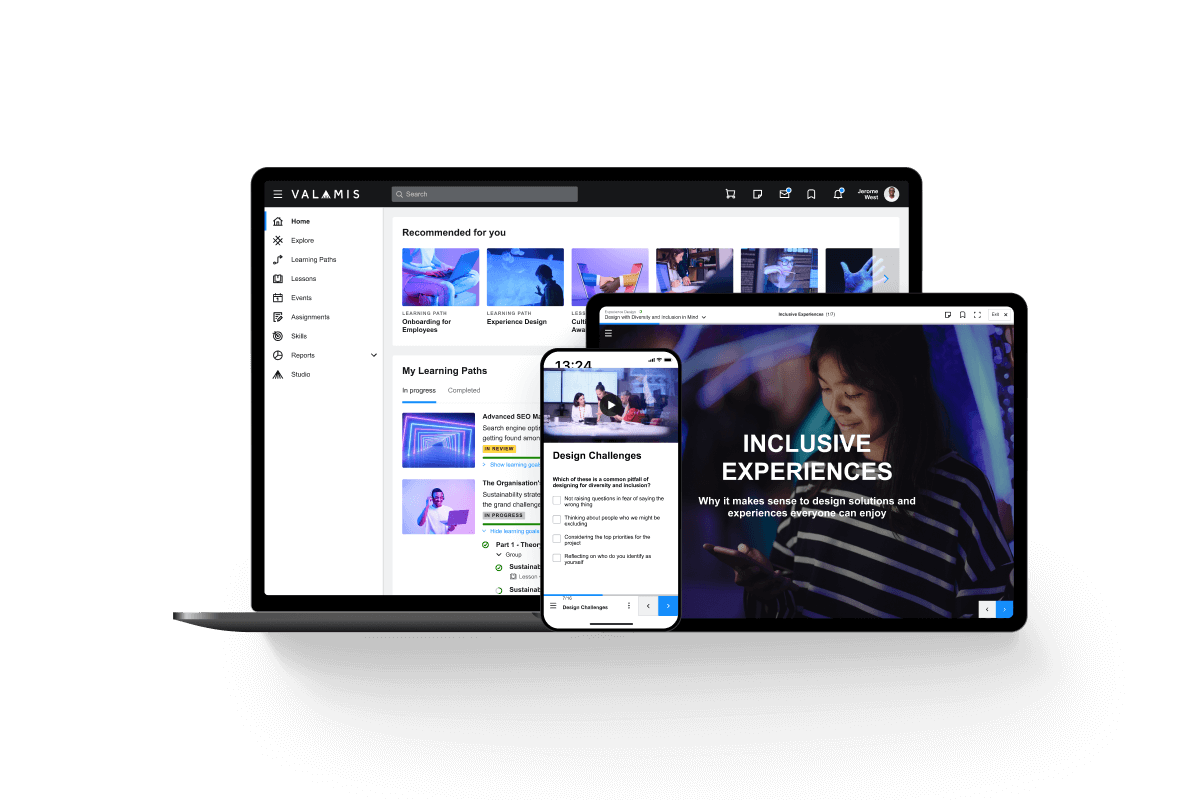
Online learning has become essential for the learning and development strategy. If you are interested in topics like employee experience, scalable onboarding programs, and learning analytics, book a Valamis demo, we are here to help.




